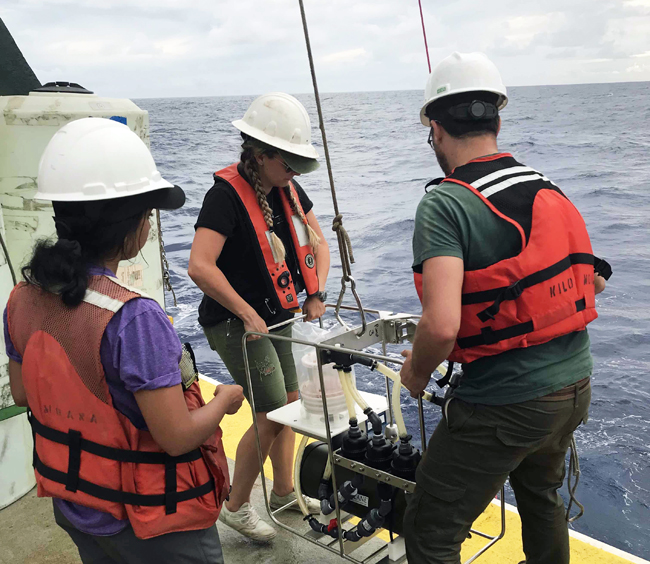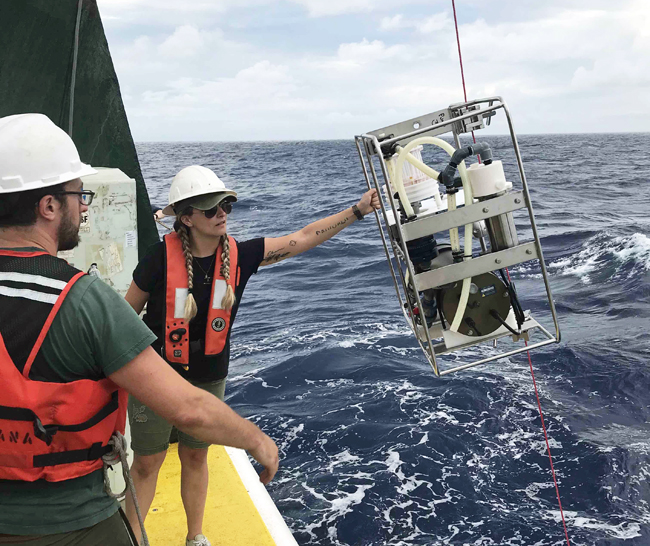After two years of delay due to the COVID-19 pandemic, University of Georgia Skidaway Institute scientists participated in their first cruise of their four-year project to study how dust in the atmosphere is deposited in the ocean and how that affects chemical and biological processes there. The team of Daniel Ohnemus and Chris Marsay, along with graduate students Charlotte “Charlie” Kollman and Mariah Ricci, joined the University of Hawaii Research Vessel Kilo Moana on a cruise out of Oahu. They collected samples at the Hawaii Ocean Time-Series Station Aloha – a six-mile wide section of ocean approximately 200 kilometers from Oahu where oceanographers from around the world study ocean conditions over long time spans. The cruise was the first of six planned during the four-year project.

(l-r) Mariah Ricci, Charlie Kollman and Dan Ohnemus prepare to deploy an instrument package.
Ohnemus is one of two chief scientists on the project along with fellow UGA Skidaway Institute researcher Clifton Buck, who did not join this cruise. He called the cruise a success.
“Everything we put in the ocean, we got back, and that’s a good thing in oceanography,” he said. “And also, most importantly, it all worked.”
The overall goal of the project is to look at the rate that dust is deposited into the ocean and what happens to it once it is in the water column. The chemistry of the ocean can be changed by the introduction and removal of elements, including trace elements which are present in low concentrations. In some cases, these elements are known to be vital to biological processes and ocean food webs.
After waiting for two years for the pandemic to ease, the science team still had additional waiting once they arrived in Hawaii. They were required to quarantine in a hotel for six days before being allowed to board the ship.
“We flew in about a week before we were expected on the ship. We got tested multiple times,” Ohnemus said. “We tested at the airport. We got a PCR test mid-quarantine. And we for tested again before boarding the ship.
“We knew we definitely did not have COVID.”
The Skidaway team shared the cruise with other scientists, and their work was scheduled on the very end of the cruise.
“The hardest part is that we were out there for five days and four nights, and all of our research and sampling took place in the last eight hours of the cruise,” Ohnemus said.

Charlie Kollman deploys an instrument package while Dan Ohnemus looks on.
For the students Charlie Kollman and Mariah Ricci the cruise was a new experience. It was Ricci’s first research cruise ever. Ironically, she and Ohnemus both took their first cruise on the RV Kilo Moana, only their cruises were 15 years apart.
For Kollman, the best part of the cruise was participating in all the work necessary to conduct the science activity from the planning process all the way through to the end and then seeing the fruits of her labor.
“It was a great experience,” Charlie Kollman said. “It is really rewarding to see all the different things we had to do like all the mechanical work.
“I think people often think of science as being constantly high value or in the lab doing really complicated stuff, but a lot of times it’s running to Home Depot four times because you don’t have the correct pipe fitting.”
Ohnemus sings the praises of his collaborators at the University of Hawaii. “They are excellent. It was great to be able sail with them after all this time,” he said. “We first wrote the proposal in 2018, and to actually get to sail together four years later was very rewarding and time well spent.”


